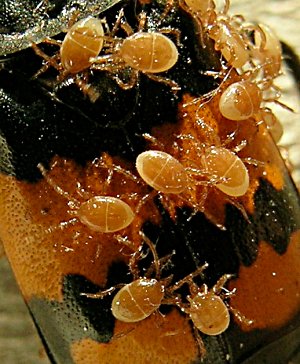Life history traits are closely linked to fitness so that selection often leaves only little room for variation. Take an organism in an environment where the optimal offspring number is ten. Perhaps the organism cannot feed more then ten offspring, and trying to raise more would result in the death of all offspring. On the other side of the spectrum, producing fewer than ten would not increase the survival chances of each individual offspring. Any gene coding for fewer or more offspring would be immediately selected out of the population. But what if the organisms moved to a novel environment where only 8 eggs are optimal, e.g. because there is less food available? The newly founded population might lack the flexibility to deal with the new environment and die out. Adaptation would only be possible if new mutations in the maladapted traits would occur.

Our lab studies the association of phoretic Poecilochirus carabi mites and their Nicrophorus burying beetle hosts. The mites use the beetles for transport to vertebrate carcasses. The beetles feed their young on the carcass. They bury the carcass and keep it from rotting. Simultaneously, the mites reproduce as well and mite offspring leave the carcass again with the beetle parents. The timing of reproduction is crucial: Mites that develop too slowly will miss the departing beetles and likely die. We found that the two German mite species are each specialised on a different burying beetle species. Mites have fewer offspring when we force them to breed with the wrong beetle species. Also, mite development time is adapted to the preferred beetle species’ duration of parental care.
The importance of a life-history trait like development for host adaptation poses an interesting problem. Host switches could be an evolutionary dead ends when they cause a mismatch and are not variable enough to quickly adapt. In a new study we selected the mites in the laboratory for quicker development. We found that there is still enough standing genetic variation in this life history trait to allow for rapid adaptation. This means that the mites have the evolutionary potential to deal with host switches and adapt to novel environments. Host switches might be a potential route to speciation: When the newly founded population specializes on their new hosts, they might become incompatible with the source population.
- Nehring, V., Müller, J.K., Steinmetz, N. (2017) Phoretic Poecilochirus mites specialise on their burying beetle hosts. Ecol. Evol. 7: 10743–10751. doi: 10.1002/ece3.3591
- Schedwill, P., Geiler, A.M., Nehring, V. (2018): Rapid adaptation in phoretic mite development time. Sci. Rep. 16460.